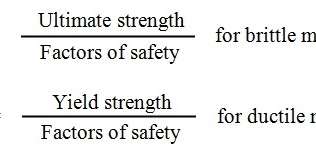Permissible stress design is a design philosophy used by mechanical engineers and civil engineers.
The civil designer ensures that the stresses developed in a structure due to service loads do not exceed the elastic limit. This limit is usually determined by ensuring that stresses remain within the limits through the use of factors of safety.
In structural engineering, the permissible stress design approach has generally been replaced internationally by limit state design (also known as ultimate stress design, or in USA, Load and Resistance Factor Design, LRFD) as far as structural engineering is considered, except for some isolated cases.
In USA structural engineering construction, allowable stress design (ASD) has not yet been completely superseded by limit state design except in the case of Suspension bridges, which changed from allowable stress design to limit state design in the 1960s. Wood, steel, and other materials are still frequently designed using allowable stress design, although LRFD is probably more commonly taught in the USA university system.
In mechanical engineering design such as design of pressure equipment, the method uses the actual loads predicted to be experienced in practice to calculate stress and deflection. Such loads may include pressure thrusts and the weight of materials. The predicted stresses and deflections are compared with allowable values that have a “factor” against various failure mechanisms such as leakage, yield, ultimate load prior to plastic failure, buckling, brittle fracture, fatigue, and vibration/harmonic effects. However, the predicted stresses almost always assumes the material is linear elastic. The “factor” is sometimes called a factor of safety, although this is technically incorrect because the factor includes allowance for matters such as local stresses and manufacturing imperfections that are not specifically calculated; exceeding the allowable values is not considered to be good practice (i.e is not “safe”).
The permissible stress method is also known in some national standards as the working stress method because the predicted stresses are the unfactored stresses expected during operation of the equipment (e.g. AS1210, AS3990).
This mechanical engineering approach differs from an ultimate design approach which factors up the predicted loads for comparison with an ultimate failure limit. One method factors up the predicted load, the other method factors down the failure stress.
Sometimes, safety is something incorporated into your office work, like personal protective equipment. Other times, safety is built into the very foundations.
Allowable stress is an excellent example of how safety and engineering intersect from the very beginning to protect people. And while you may not be an engineer, allowable stress meaning and applications are important for EHS professionals to translate safe building principles to safe worker practices.
Here’s a closer look at what allowable stress means, how it applies in your workplace, and how you can use allowable stress to drive safety in your work environment.
Allowable Stress: Meaning and Uses
Allowable stress, or allowable strength, is the maximum stress that can be safely applied to a structure. This is usually defined in building codes and the strength of the metal in question.
In the allowable stress design method, the designer must size the anchorage in such a way that the service load does not exceed the allowable load. The designer has to read the allowable load from the applicable table and adjust for all applicable design parameters for the anchor.
Calculating Allowable Stress
Because the allowable stress determines how much weight a structure can safely bear, it’s a critical piece of design information for an engineer. Calculating allowable stress is a relatively straightforward process.
Allowable stress is determined by a factor of safety and the yield strength of the object, i.e. the stress at which the object will be permanently damaged. As such, calculating allowable stress begins with finding the yield strength of the materials in question.
From there, select a factor of safety. These are usually set by the industry in question since different industries need materials to perform in different ways. If there is no industry standard set, a good overall safety factor is 4.
After that, simply divide the yield strength by the factor of safety to calculate the allowable stress.
How an Engineer Applies Allowable Stress in Safety
In safety, allowable stress is a critical factor in maintaining a sound, stable structure. Without knowing the allowable stress, an engineer won’t know what load a structure can safely bear. When we talk about allowable stress, we’re really talking about how much weight is safe to put on a structure.
The applications in safety are obvious. Take construction, for example, where workers routinely deal with heavy loads. When they’re building a structure, they have to know the allowable stress so they don’t overload it and cause collapse. A scaffold is one example – it’s safe as long as it has a manageable load.
Strengthen Your Safety Understanding
While it’s easy to discard the allowable stress meaning and applications as a concern for engineers, including safety engineers, the truth is that it applies to your work every day. A structure is no longer safe if workers overload it, which means you need to understand how allowable stress works and how it translates into safe work practices. If you’re looking for a smarter way to translate key safety topics into actionable results, our safety management software makes it easy to know where you stand.
The terminology can be confusing.
Typically, the working load, or sometimes called the design load , is the maximum actual load that will be applied without any overload factor. Under this working load, the stress shall not exceed the maximum allowable working stress, where the max allowable working stress is the failure stress divided by a safety factor.
The other way to do it is to apply an overload factor to the max actual load, then the stress under this factored load shall not exceed the failure stress. The failure stress is usually the yield stress of the material, or the stress at buckling.
There are Code provisions also that modify this somewhat.
For the problem at hand, the stresses shall not exceed the given allowable stresses when the system is subject to the given load.
Failure stresses at yield are a property of the material, and must be given or tabulated somewhere.
[
Working Stress:
Working stress is the safe stress taken withinthe elastic range of the material. For brittle materials, it is taken equal tothe
is the safe stress taken within the elastic range of the material. For brittle materials, it is taken equal to the ultimate strength divided by suitable factor of safety. However, for materials possessing well defined yield point, it is equal to yield stress divided by a factor of safety. It is the stress which accounts all sorts of uncertainties.

It is also called allowable stress, permissible stress, actualstress and safe stress.
Factor of Safety:
Factor of safety is a numberused to determine the working stress. It is fixed based on the experimentalworks on the material. It accounts all uncertainties such as, material defects,unforeseen loads, manufacturing defects, unskilled workmanship, temperature effectsetc. Factor of safety is a dimensionless number. It is fixed based onexperimental works on each material.

It is defined as the ratio of ultimate stress to working stress for brittle materials or yield stress working stress for ductile materials.



